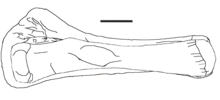Laplatasaurus
| Laplatasaurus | |
|---|---|

| |
| Tibia & fibula of Laplatasaurus. Scale bar equals 10cm. | |
| Scientific classification | |
| Domain: | Eukaryota |
| Kingdom: | Animalia |
| Phylum: | Chordata |
| Clade: | Dinosauria |
| Clade: | Saurischia |
| Clade: | †Sauropodomorpha |
| Clade: | †Sauropoda |
| Clade: | †Macronaria |
| Clade: | †Titanosauria |
| Genus: | †Laplatasaurus von Huene, 1929 |
| Type species | |
| †Laplatasaurus araukanicus von Huene, 1929
| |
| Synonyms | |
| |
Laplatasaurus (meaning "La Plata lizard", named for
Naming and description
The genus was named in 1927 by
that perhaps originate from different individuals.Huene assigned those fossils to Laplatasaurus that seemed to indicate a rather large yet at the same time elegantly built sauropod. The about eighteen metres (60 ft) long Laplatasaurus was perhaps similar to
A Megaloolithus egg found in the Anacleto Formation in Auca Mahuevo, Argentina[5] that was once assigned to Titanosaurus may have instead been laid by Laplatasaurus.
Taxonomy
Huene placed Laplatasaurus in the
A 2015 re-assessment of Laplatasaurus found it to be closely related to Bonitasaura, Futalognkosaurus, Mendozasaurus, and Uberabatitan. The genus was restricted to the lectotype, and the material from Rancho de Avila was assigned to cf. Bonitasaura sp.[4]
References
- ^ Huene, F. von, 1927, "Sichtung der Grundlagen der Jetzigen Kenntnis der Sauropoden", Eclogae geologicae Helvetiae, 20: 444-470
- ^ Huene, F. von, 1929, Los Saurisquios y Ornithisquios de Cretaceo Argentino, Anales Museo de La Plata, 2nd series, v. 3, p. 1-196
- ^ Huene, F. von, and Mately C. A., 1933, "The Cretaceous Saurischia and Ornithischia of the central provinces of India", Palaeontologia Indica, 21: 1-74
- ^ S2CID 131595654.
- ^ Megaloolithus at Fossilworks.org
- ^ Powell, J. E., 2003, "Revision of South American titanosaurid dinosaurs: palaeobiological, palaeobiogeographical and phylogenetic aspects", Records of the Queen Victoria Museum 111: 1-173
- S2CID 53997295.
- ISBN 0-520-24209-2, S. 259–322.
- ^ Salgado, L. & Coria, R. A. 2005. Sauropods of Patagonia: Systematic update and notes on Global Sauropod evolution. In. Thunder-Lizards. The Sauropodomorph Dinosaurs. Ed. V. Tidwell & K. Carpenter. Indiana University Press. Bloomington and Indianapolis. Indiana University Press430-453.
